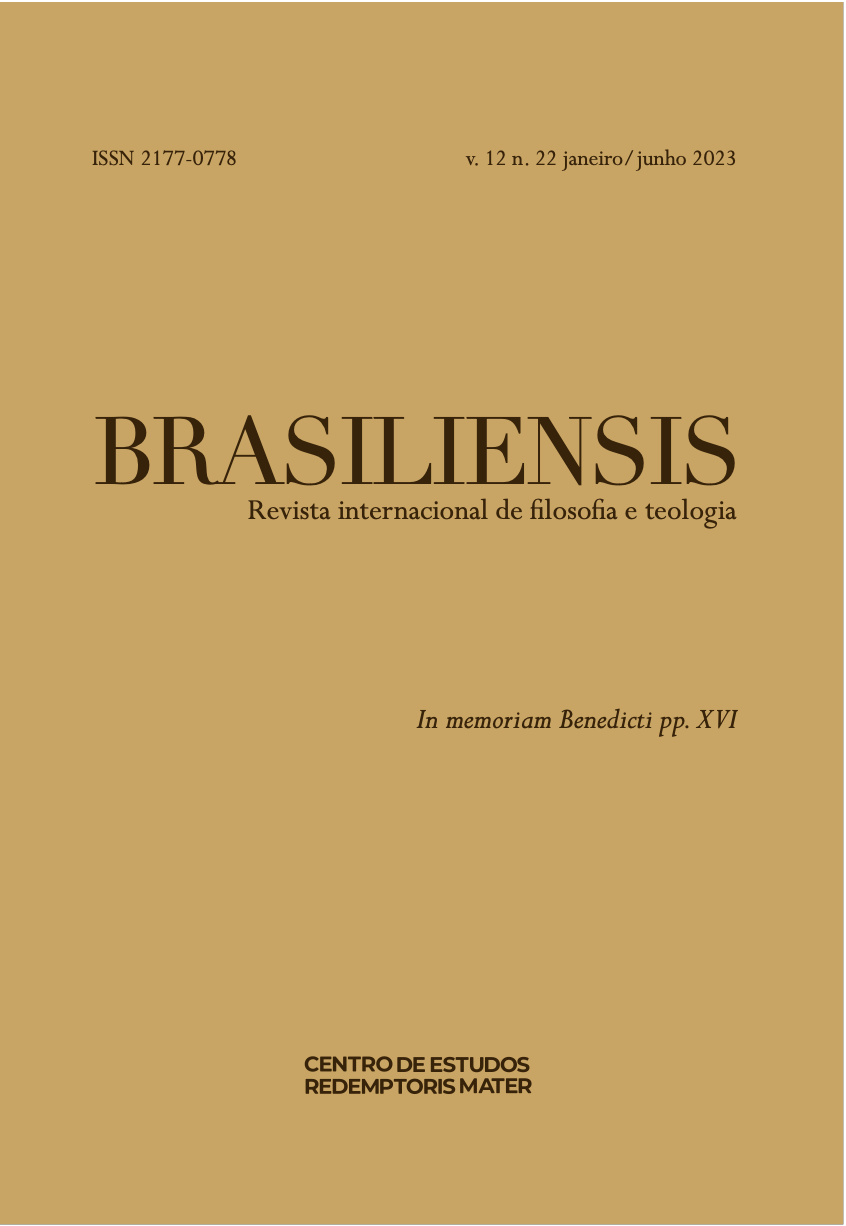Quem é o Senhor para que escute sua voz? A caracterização do personagem divino em Ex 14
Conteúdo do artigo principal
Resumo
Consiste em uma análise narratológica do relato do milagre da travessia a pé enxuto do povo de Israel pelo mar dos juncos, presente em Ex 14. Centra-se sobre o aspecto relativo à caracterização dos personagens ao interno do enredo (μῦθος) narrativo, conforme já explanado em artigo precedente. O personagem escolhido como objeto desta análise é o protagonista mesmo da perícope, que é também o protagonista de toda a narrativa bíblica, ou seja, o personagem de Deus. Para isso, proceder-se-á com uma breve análise estrutural e dinâmica do enredo, seguida de um estudo acerca dos elementos narrativos dignos de destaque que fundamentam as conclusões teológicas, que finalizaram o artigo.
Detalhes do artigo

Este trabalho está licenciado sob uma licença Creative Commons Attribution-NonCommercial-NoDerivatives 4.0 International License.
A licença Creative Commons Atribuição (CC BY) é a licença mais permissiva da Creative Commons. Ela permite que outros distribuam, remixem, adaptem e construam sobre sua obra, inclusive para fins comerciais, desde que lhe atribuam o devido crédito pela criação original.
Como Citar
Referências
Auzou, G. (2008). Dalla servitù al servizio. Il libro dell’Esodo. Dehoniane. Bar-Efrat, S. (1989). Narrative Art in the Bible, Sheffield. A&C Black.
Beauchamp, P. (2010). Création e séparation. Étude exégétique du chapitre premier de la Genèse. Cerf.
Beauchamp, P. (2019). L’Uno e l’Altro Testamento: II. Compiere le Scritture (A. Bertuletti, trad.). Glossa.
Brown, F., Driver, S. R., & Briggs, C. A. (1996). A Hebrew and English Lexicon of the Old Testament, Hendrickson Publishers.
Buber, M. (1983). Mosè (P. Di Segni, trad.; P. C. Bori, intr.). Marietti.
Cassuto, U. (1967). A Commentary on the Book of Exodus. The Magnes Press. Chatman, S. (1987). Story and Discourse. Narrative Structure in Fiction and Film. Cornell University Press.
Cox, D. G. C. (2006). The Hardening of Pharaoh’s Heart in its Literary and Cultural Context. Bibliotheca Sacra 163, 292-311.
Davies, G. I. (2020). A critical and exegetical commentary on Exodus 1-18. (Vols. I e II). Bloomsbury Publishing.
Eslinger, L. (1991). Freedom or knowledge? Perspective and purpose in the exodus narrative (Exodus 1-15). Journal for the Study of the Old Testament, 16(52), 43-60.
Genette, G. (1972). Figures III (Collection “Poétique”). Éditions du Seuil.
Gunn, D.M. (1982). The ‘Hardening of Pharaoh’s Heart’: Plot, Character and Theology in Exodus 1–14. Em D.J.A. Clines – D.M. Gunn – A.J. Hauser (Eds.), Art and Meaning: Rethoric in Biblical Literature, JSOTS Press, 72-96.
De Lima Podda, V. (2022), A arte da suspensão: um breve ensaio sobre a fenomenologia da caracterização do personagem bíblico. Brasiliensis, 11(2), 75-88.
Hamilton, V.P. (2011). Exodus. An Exegetical Commentary, Baker Academic. Marguerat, D., & Bourquin, Y. (1998), Pour lire les récits bibliques. La Bible se raconte. Initiation à l’analyse narrative, Cerf.
Meyers, C. (2005). Exodus. Cambridge University Press.
Meynet, R. (2004). Le passage de la mer (Ex 14). Analyse réthorique, Rivista teologica di Lugano, 9(3), 569-590.
Meynet, R. (2008). Appelés à la liberté, Lethielleux.
Michaeli, F. (1974). Le Livre de l’Exode (CAT 2). Delachaux & Niestlé.
Murphy, J.G. (1868). Critical and Exegetical Commentary on Exodus. W.F. Draper. Noth, M. (1977). Esodo (G. Cecchi, Trad.; G. Odasso, Ed.). Paideia.
Obara, E.M. (2016). Notte di veglia per il Signore. Lettura pragmatica del ‘miracolo del Mar Rosso’ (Lectio 9). Em J.-P. Sonnet, La Bibbia si apre a Pasqua. Lezionario della Veglia pasquale: storia, esegesi, liturgia. San Paolo, Gregorian & Biblical Press, 83-99.
Propp, W.H.C. (1999). Exodus 1–18. A New Translation with Introduction and Commentary (The Anchor Bible, Vol. 2). Doubleday.
Rashi de Troyes. (1988). Commento all’Esodo. S. J. Sierra (Ed.), Marietti.
Ravasi, G. (1988) Il Libro dei Salmi: commento e attualizzazione (Vol. I. Salmi
–50. Ed. 4), Edizioni Dehoniane Bologna.
Sarna, N. M. (1991). Exodus Shemot. The Traditional Hebrew Text with the New JPS Translation, Jewish Publication Society.
Shupak, N. (2004), Hzq, Kbd, Qsh Leb, The Hardening of Pharaoh’s Heart in Exodus 4-15:21: Seen Negatively in the Bible but Favorably in Egyptian Sources. Em G.N. Knoppers, A. Hirsch, Egypt, Israel, and the Ancient Mediterranean World: Studies in Honor of Donald B. Redford, Brill, 389-404.
Ska, J.-L. (1979). Les Plaies d’Égypte dans le récit sacerdotal (PG). Biblica 60(1), 23-35. Ska, J.-L. (1997). Le passage de la mer : Étude de la construction, du style et de la symbolique d’Ex 14,1-31. Editrice Pontificio Istituto biblico.
Ska, J.-L. (2006). I volti insoliti di Dio. Meditazioni bibliche. Edizioni Dehoniane Bologna. Ska, J.-L. (2012). ‘I nostri padri ci hanno raccontato’. Introduzione all’analisi dei racconti dell’Antico Testamento (R. Fabbri, Trad.). Edizioni Dehoniane Bologna. Ska, J.-L. (2021). Il libro dell’Esodo. Edizioni Dehoniane Bologna.
Ska, J.L., Sonnet, J.-P., Wénin, A. (2001). Análisis narrativo de relatos del Antiguo Testamento. Verbo Divino.
Sonnet, J.-P. (2010). L’analisi narrativa dei racconti biblici. Em M. Bauks, C. Nihan Manuale di esegesi dell’Antico Testamento (F. Ficco, Trad.), Bologna, 45-85. Sternberg, M. (1978). Expositional Modes and Temporal Ordering in Fiction. The John Hopkins University Press1978.
Sternberg, M. (1987). The Poetics of Biblical Narrative. Ideological Literature and the Drama of Reading (ISBL 453). Indiana University Press.
Tomes, R. (1969). Exodus 14: The Mighty Acts of God. An Essay in Theological Criticism. Scottish Journal of Theology, 22(4), 455-478.
Utzschneider, H., & Oswald, W. (2013). Exodus 1–15 (Internationaler Exegetischer Kommentar zum Alten Testament). Kohlhammer.
Vervenne, M. (1994). The Sea Narrative Revisited, Biblica 75(1), 80-98.
Viviano, B. T. (1997). A Psychology of Faith: Matt 27:54 in the Light of Exod 14:30-31. Revue Biblique 104, 368-372.
Yang, K. H. (2018). From ‘Fear’ or ‘the Fear of the Lord’: A Study on the Motif of Fear in Exodus, Journal for Baptist Theology & Ministry, 15(2), 19-29.

